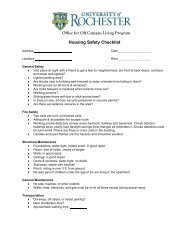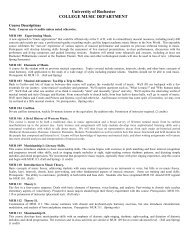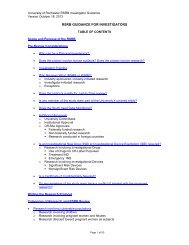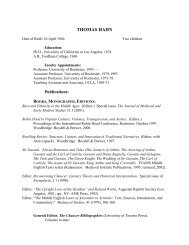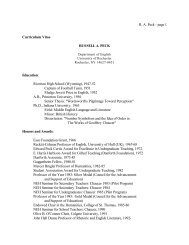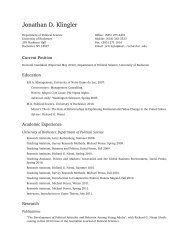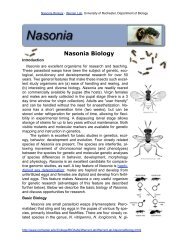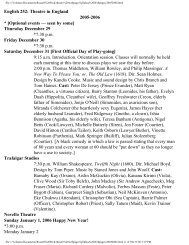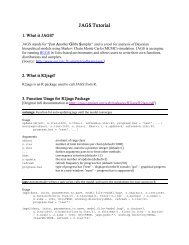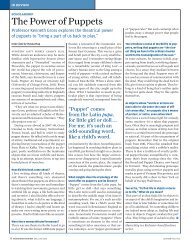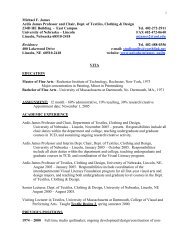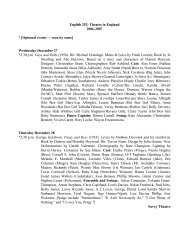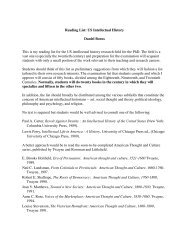In Review - University of Rochester
In Review - University of Rochester
In Review - University of Rochester
You also want an ePaper? Increase the reach of your titles
YUMPU automatically turns print PDFs into web optimized ePapers that Google loves.
28 three- to five-year-olds to two contrasting<br />
environments: unreliable and reliable.<br />
The study results were so strong that a larger<br />
sample group wasn’t required to ensure<br />
statistical accuracy. <strong>In</strong> both groups the children<br />
were given a “create-your-own-cup”<br />
kit and asked to decorate a blank paper that<br />
would be inserted into a cup.<br />
<strong>In</strong> the unreliable condition, the children<br />
were provided a container <strong>of</strong> used crayons<br />
and told that if they could wait, the researcher<br />
would return shortly with a bigger<br />
and better set <strong>of</strong> new art supplies for their<br />
project. After two-and-a-half minutes, the<br />
researcher returned, apologizing that there<br />
were no other art supplies after all.<br />
Next a quarter-inch sticker was placed<br />
on the table, and the children were told that<br />
if they could wait, the researcher would return<br />
with a large selection <strong>of</strong> better stickers<br />
to use. After the same wait, the researcher<br />
again returned empty handed.<br />
The reliable group experienced the same<br />
set up, but the researcher returned with the<br />
promised materials: first with a rotating<br />
tray full <strong>of</strong> art supplies and the next time<br />
with five to seven large stickers.<br />
The marshmallow task followed, with<br />
the explanation that the child could have<br />
“one marshmallow right now. Or—if you<br />
can wait for me to get more marshmallows<br />
from the other room—you can have<br />
two marshmallows to eat instead.” The<br />
researcher removed the art supplies and<br />
placed a single marshmallow in a small dessert<br />
dish directly in front <strong>of</strong> the child.<br />
Kids danced in their seats, sang, and took<br />
pretend naps. Several took a bite from the<br />
bottom <strong>of</strong> the marshmallow then placed<br />
it back in the dessert cup so it looked<br />
untouched.<br />
“We had one little boy who grabbed the<br />
marshmallow immediately, and we thought<br />
he was going to eat it,” recalls Kidd. But he<br />
sat on it. “<strong>In</strong>stead <strong>of</strong> covering his eyes, he<br />
covered the marshmallow.”<br />
Children who experienced unreliable<br />
interactions with an experimenter waited<br />
for a mean time <strong>of</strong> three minutes and two<br />
seconds on the marshmallow task, while<br />
youngsters who experienced reliable interactions<br />
held out for 12 minutes and 2<br />
“Being able to delay gratification—in this case<br />
to wait 15 difficult minutes to earn a second<br />
marshmallow—not only reflects a child’s<br />
capacity for self-control, it also reflects their<br />
belief about the practicality <strong>of</strong> waiting.”<br />
—Celeste Kidd, doctoral candidate in brain<br />
and cognitive sciences<br />
<strong>In</strong> RevIew<br />
seconds. Only one <strong>of</strong> the 14 children in the<br />
unreliable group waited the full 15 minutes,<br />
compared to nine children in the reliable<br />
condition.<br />
“I was astounded that the effect was so<br />
large,” says Aslin. “I thought that we might<br />
get a difference <strong>of</strong> maybe a minute or so.<br />
You don’t see effects like this very <strong>of</strong>ten.”<br />
<strong>In</strong> prior research, children’s wait time<br />
averaged between 5.71 and 6.08 minutes,<br />
the authors report. By comparison, manipulating<br />
the environment doubled wait<br />
times in the reliable condition and halved<br />
the time in the unreliable scenario.<br />
The robust environmental effect provides<br />
strong evidence that the wait times reflect<br />
the children’s rational decision making<br />
about the probability <strong>of</strong> reward, the authors<br />
conclude. The results are consistent with<br />
other research showing that children are<br />
sensitive to uncertainty in future rewards.<br />
So does that mean that if little ones gobble<br />
up dessert without waiting, parents<br />
should worry that they have failed to be<br />
role models <strong>of</strong> reliability?<br />
“Children do monitor the behavior <strong>of</strong> parents<br />
and adults, but it’s unlikely that they’re<br />
keeping detailed records <strong>of</strong> every single action,”<br />
says Aslin. “It’s the overall sense <strong>of</strong> a<br />
parent’s reliability or unreliability that’s going<br />
to get through, not every single action.”<br />
Adds Kidd: “Don’t do the marshmallow<br />
test on your kitchen table and conclude<br />
something about your child. It especially<br />
would not work with a parent, because<br />
your child has all sorts <strong>of</strong> strong expectations<br />
about what a person who loves them<br />
very much is likely to do.”r<br />
November–December 2012 ROCHESTER REVIEW 15



